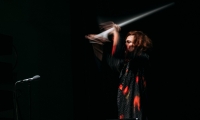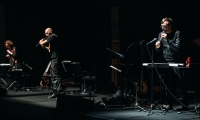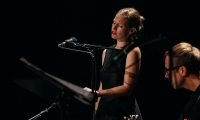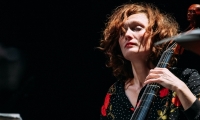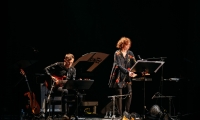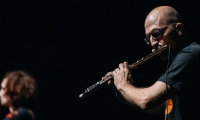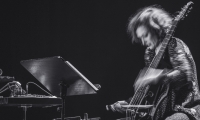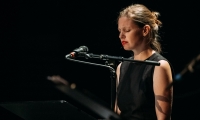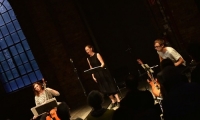AUDIO
On SoundCloud

MUSICIANS
Theresa Dlouhy soprano
Eva Reiter viola da gamba
Tom Pauwels electric and acoustic guitars
Michael Schmid flutes

PROGRAMME
EVA REITER (°1976) Dr Best, for electric gamba and tape 10’
JÜRG FREY (born 1953) Abendlied, from « 50 Sächelchen » for guitar 1'30
JOHN DOWLAND (°1563) Mourne, Mourne, Day is with Darkness fled, for voice, gamba, guitar; What if A Day, for guitar 4'
ARTHUR LAVANDIER (°1987) My Naked Lady framed for soprano and gamba 1’
TOBIAS HUME (°1569) What greater Grief, for voice and gamba
TOBIAS HUME (°1569)Loves Farewell, for solo gamba 6'
EVA REITER (°1976) My iron-spurred Lady, for performer and guitar 8'
for pedal board and e-guitar
EVA REITER (°1976) Improv Trio, for slide flute and 2 performers playing tubes 10’
WOLFGANG MITTERER (°1958) Mourn, Mourn for soprano, gamba and guitar 3'
JÜRG FREY (°1953) Cadillac, from « 50 Sächelchen » for guitar 1'
BERNHARD GANDER (°1959) Darkness awaits us for soprano and gamba 5’
THOMAS CAMPIAN (°1567) All looks be pale for soprano, gamba and lute 2'
FRANCESCO FILIDEI (°1973) … And here they do not for soprano and gamba 3'
JOHN DOWLAND (°1563) Time stands still, for soprano, gamba and guitar 3'
STEPHEN GOODALL (°1650) Untitled, for solo gamba 2'
BERNHARD GANDER (°1959) Lamenti I, for gamba and guitar
EVA REITER (°1976) Konter, for double bass flute and tape 10’
JÜRG FREY (°1953) No 32, from « 50 Sächelchen » for guitar
BURKHARD STANGL (°1960) Nights for soprano, gamba and guitar 3'
BURKHARD STANGL (°1960) With you for soprano, gamba and guitar 2'

A concert programme of short songs, from the past and present, as they used to say in times that have become such a distant memory,
that we often wonder whether they really existed or whether they were just a dream
(but who can prove that we are really awake? ). A concert that verges on simplicity, calm and sadness,
were it not that you can feel that the musicians are consumed by a passion for all things ornamental, the twilight zone and the bizarre.

Between contemporary and Renaissance repertoires, the concert performed by this quartet is an ode to the “black bile” — the melancholy pitch, the saturnine liqueur, without which musicians would have such an inane smile on their faces that we might be tempted to punch them.

A clear voice without vibrato, an acoustic or electric guitar, a transformed double bass flute, Eva Reiter’s subtle way of playing the viola da gamba — all slightly amplified — form a patchwork of tormented and delightful miniatures: short bitter-sweet melodies, Purcell-style ostinati (with the music of Filidei, for example), pop songs that have been slowed down a hundred times, nocturnal confidences …
When time fragments and the past wavers...

Agamben:
Acedia: sadness, depression. Guillaume d'Auvergne describes a person afflicted with acedia as being “sick of God”. This tædium dei, this disgust of God, represents the greatest of sins. According to Giorgio Agamben, medieval acedia can take on the following forms:
In the first place there is malitia (malice, ill will), the ambiguous and unstoppable love-hate for good in itself, and rancor (resentment), the revolt of the bad conscience against those who exhort it to good;
pusillanimitas, the ‘small soul’ and the scruple that withdraws crestfallen before the difficulty and the effort of spiritual existence;
desperatio, the dark and presumptuous certainty of being already condemned beforehand and the complacent sinking into one’s own destruction, as if nothing, least of all divine grace, could provide salvation;
torpor, the obtuse and somnolent stupor that paralyzes any gesture that might heal us; and finally, evagatio mentis (wandering of the mind), the flight of the will before itself and the restless hastening from fantasy to fantasy. The latter manifests itself in verbositas (garrulity), the proliferation of vain and tedious speech; curiositas, the insatiable desire to see for seeing’s sake that disperses in always new possibilities.
(Giorgio Agamben, Stanze 1977)
Een concert met korte liederen van gisteren en van vandaag, zoals men vroeger wel zei, een vroeger dat al zo vervaagd is
dat je je afvraagt of het wel bestaan heeft of dat we het enkel gedroomd hebben — maar wie bewijst dat we wakker zijn? —,
een concert dat rust, eenvoud en somberte uitstraalt, maar toch gedreven wordt de passie van de muzikanten
voor alles wat mooi, duister en bizar is.

Dit kwartetconcert pendelt tussen hedendaags en renaissancerepertoire en brengt een ode aan de ‘zwarte gal’ — die melancholische pek, een saturnische cocktail die de musici zo’n dwaze glimlach op hun gezicht tovert dat je hen zowaar een klap zou willen verkopen.

Een heldere stem zonder vibrato, een akoestische of elektrische gitaar, een contrabasfluit en de zo rijk genuanceerde viola da gamba van Eva Reiter – dat alles met lichte geluidsversterking – weven een patchwork van giftige, sappige miniaturen: korte, bitterzoete melodieën, ostinati à la Purcell (in het werk van Filidei bijvoorbeeld), extreem vertraagde popsongs, nachtelijke ontboezemingen …
Als de tijd verbrokkelt en het verleden stokt …

Agamben:
Acedia: bedroefdheid, neerslachtigheid. Volgens Willem van Auvergne “ademt de acediaan de walging van God”. Dat tædium dei, die afschuw van God, is de doodzonde. Volgens Giorgio Agamben kan de middeleeuwse acedia de volgende gedaantes aannemen:
Malitia, een ambivalente en onbedwingbare haat-liefde voor het goede als dusdanig, en rancor, het verzet van het slechte geweten tegen zij die tot het goede aansporen;
pusillanimitas, ‘kleinzieligheid’, een angstvallige schrik voor de moeilijkheden en eisen van het spirituele leven;
desperatio, de duistere en zelfingenomen zekerheid dat men van tevoren gedoemd is, een zelfgenoegzame neiging zich in de eigen ondergang te storten alsof niets, zelfs niet de genade Gods, redding kan brengen;
torpor, de afstompende en verlammende verbijstering die elke handeling blokkeert die genezing zou kunnen brengen;
en tot slot evagatio mentis, de vlucht van de geest voor zichzelf, de rusteloze opeenvolging van dagdroom na dagdroom die zich vertaalt naar verbositas, het verspreiden van ijdele praatjes over zichzelf, en naar curiositas, een onverzadigbare dorst om te zien louter voor het zien, een dorst die verdrinkt in mogelijkheden die zich keer op keer opnieuw aandienen.
(Giorgio Agamben: Stanze. Giulio Einaudi, Turijn, 1977)
We wensen je een aangenaam concert!
La musique met dans cet état que j’appellerai de tristesse, avec ce que le mot a de fort, la grande tristesse de Schubert ou de Schumann, l’immense tristesse qui est à la mesure du monde et qui n’est pas sentimentale. Elle est nécessaire à l’inspiration. C’est un état d’attendrissement sur l’univers, et un peu sur soi aussi. On n’écrit pas dans la méchanceté, c’est évident. Et en même temps, c’est une mise en cohérence de tout ce qui est possible, de tout ce que l’on connaît culturellement, une sorte d’appel aussi à l’art en général, aux artistes qui vous ont précédé, aux grands ancêtres. — Pierre Guyotat

Un concert fait de courtes chansons d'hier et d'aujourd'hui, comme on disait en des temps à ce point évanouis qu'on se demande s'ils ont existé, ou si nous avons rêvé — mais qui prouve que nous soyons éveillés ? —,
un concert à deux doigts d'être tout calme, tout simple et tout triste,
si l'on ne sentait pas les musiciens à ce point habités par la passion de l'ornementé, du crépusculaire et du bizarre.

Entre répertoires contemporain et renaissant, ce concert en quatuor est une ode à la « bile noire » — la poix mélancolique, la liqueur saturnienne, sans laquelle les musiciens arboreraient un sourire si niais qu’on se prendrait à les gifler.
Une voix claire et sans vibrato, une guitare acoustique ou électrique, une flûte dé-naturée par la microphonie et la viole de gambe toute en nuances d’Eva Reiter tissent un patchwork de miniatures empoisonnées et succulentes : courtes mélodies douces-amères, ostinati à la Purcell, chansons pop ralenties cent fois, confidences nocturnes…
Quand le temps se fragmente et que le passé ne passe plus.

Agamben:
Acedia : tristesse, dépression. Pour Guillaume d'Auvergne, « l’acédieux a la nausée de Dieu ». Ce tædium dei, ce dégoût de Dieu, constitue le péché des péchés. Selon Giorgio Agamben, l’acedia médiévale peut prendre les visages suivants :
Malitia, amour-haine ambigu et irrépressible pour le bien comme tel, et rancor, révolte de la mauvaise conscience contre ceux qui exhortent au bien ;
pusillanimitas, «petitesse d’âme», effarement scrupuleux devant les difficultés et les exigences de la vie spirituelle;
desperatio, obscure et présomptueuse certitude d’être condamné d’avance, tendance complaisante à s’abîmer dans sa ruine, comme si rien, pas même la grâce divine, ne pouvait assurer le salut ;
torpor, obtuse et paralysante stupeur qui bloque tout geste susceptible d’amener la guérison;
et enfin evagatio mentis, fuite de l’âme en avant, course inquiète de rêverie en rêverie qui se traduit par la verbositas, verbiage proliférant vainement sur lui-même et par la curiositas, soif insatiable de voir pour voir qui se perd en possibilités toujours renouvelées.
(Giorgio Agamben, Stanze, 1977)
Bon, allez, bon concert !
Agenda for this project
- Date Show Location
-
Fri 28.09 Darker than Black [extended] The Great Amber - Liepāja - Latvia

Darker than Black [extended]
Multi-repertoires chamber music, from Renaissance to contemporary read more
- Date Show Location
-
Wed 09.10 Darker Than Black Elbphilharmonie - Hamburg - Germany

Darker than Black [extended]
Multi-repertoires chamber music, from Renaissance to contemporary read more


